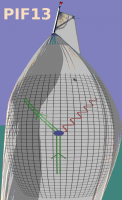Dr
Falk Bruckmann
(Regensburg University)
10/07/2013, 09:10
oral presentation
I review the recent progress concerning QCD with external fields, especially the catalysis resp. inverse catalysis of the quark condensate, the critical temperature, the magnetic susceptibility etc. from lattice simulations in comparison to other approaches.
Dr
Kazunori Itakura
(KEK Theory Center, IPNS, KEK)
10/07/2013, 09:35
oral presentation
Extremely strong magnetic fields appear in high-energy heavy-ion collisions and compact stars like magnetars. Under such strong magnetic fields, photons and even hadrons show unusual behaviors. In this talk, I will explain photon's vacuum birefringence and decay into an e+e- pair [1,2] and the conversion of neutral pions into (virtual) photons [3] both of which are possible in strong magnetic...
Naoto Tanji
(IPhT Saclay/ KEK)
10/07/2013, 10:00
oral presentation
A high-energy nucleus can be viewed as a condensed state of high-density and weak-coupling gluons, which is called color glass condensate. After a collision of heavy nuclei, these gluons are emitted between the two nuclei and they can be interpreted as coherent classical chromo-electromagnetic
fields polarized in the longitudinal beam direction. The strength of these fields is given by the...
Dr
Tigran Kalaydzhyan
(DESY)
10/07/2013, 10:20
oral presentation
We study electromagnetic and topological properties of the QCD vacuum and quark-gluon plasma in the background of strong (hadronic scale) magnetic fields comparable to the ones taking place in heavy-ion collisions. Among the properties are the following ones: electric conductivity, magnetization and magnetic susceptibility, local CP-violation and induced anomalous currents, distribution of the...

